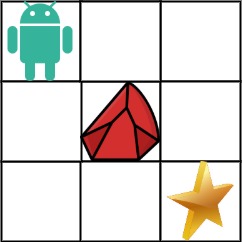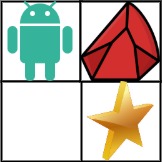Problem Description
You are given an m x n integer array grid. There is a robot initially located at the top-left corner (i.e., grid[0][0]). The robot tries to move to the bottom-right corner (i.e., grid[m - 1][n - 1]). The robot can only move either down or right at any point in time.
An obstacle and space are marked as 1 or 0 respectively in grid. A path that the robot takes cannot include any square that is an obstacle.
Return the number of possible unique paths that the robot can take to reach the bottom-right corner.
The testcases are generated so that the answer will be less than or equal to 2 * 109.
Example 1:

Input: obstacleGrid = [[0,0,0],[0,1,0],[0,0,0]] Output: 2 Explanation: There is one obstacle in the middle of the 3x3 grid above. There are two ways to reach the bottom-right corner:
- Right -> Right -> Down -> Down
- Down -> Down -> Right -> Right
Example 2:

Input: obstacleGrid = [[0,1],[0,0]] Output: 1
Constraints:
m == obstacleGrid.lengthn == obstacleGrid[i].length1 <= m, n <= 100obstacleGrid[i][j]is0or1.
Difficulty: Medium
Tags: array, dynamic programming, matrix
Rating: 94.50%
Solution
Here’s my Python solution to this problem:
class Solution:
def uniquePathsWithObstacles(self, obstacleGrid: List[List[int]]) -> int:
m, n = len(obstacleGrid), len(obstacleGrid[0])
dp = [[0] * n for i in range(m)]
for i in range(m):
if obstacleGrid[i][0] == 1:
break
else:
dp[i][0] = 1
for j in range(n):
if obstacleGrid[0][j] == 1:
break
else:
dp[0][j] = 1
for i in range(1, m):
for j in range(1, n):
if obstacleGrid[i][j] == 1:
continue
dp[i][j] = dp[i-1][j] + dp[i][j-1]
return dp[m-1][n-1]
Complexity Analysis
The solution has the following complexity characteristics:
- Time Complexity:
- Space Complexity:
Note: This is an automated analysis and may not capture all edge cases or specific algorithmic optimizations.